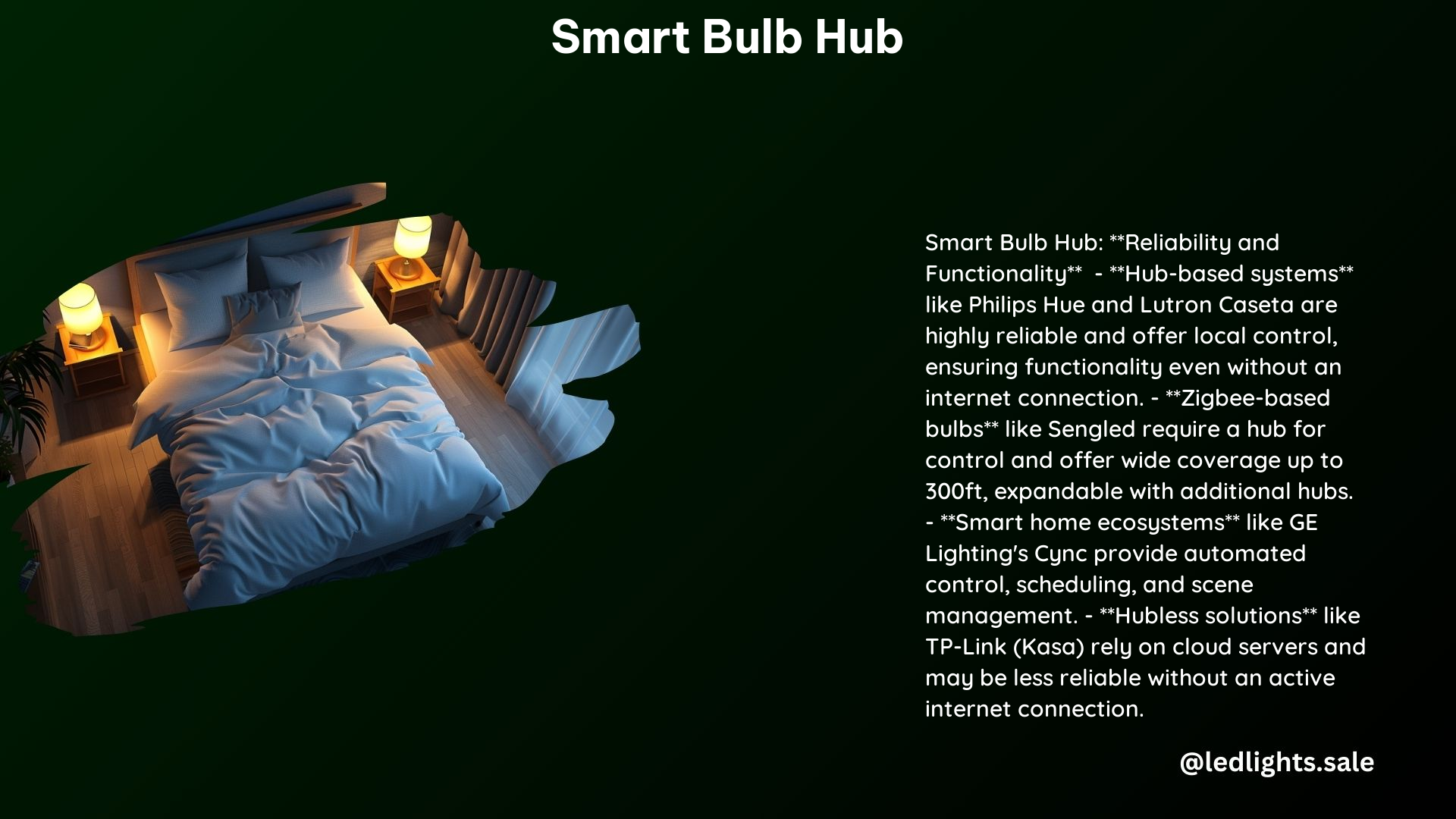Smart home technology has revolutionized the way we interact with our living spaces, and smart bulbs are at the forefront of this revolution. While some smart bulbs can operate independently without a hub, others require a dedicated hub to unlock their full potential. In this comprehensive guide, we’ll explore the benefits of using smart bulbs that need a hub, the technical specifications of popular smart bulb hubs, and how they can enhance the programmability of your smart home setup.
Benefits of Using Bulbs that Need a Hub
Reliability and Stability
Hub-based smart lights are generally more reliable and stable compared to those without a hub. They are less prone to connectivity issues and can maintain a stable connection even when the internet is down. This is because the hub acts as a central control point, managing the communication between the bulbs and the rest of the smart home ecosystem.
Local Control
Hubs like Philips Hue and Sengled allow for local control, meaning that automations and routines are stored and triggered locally, ensuring that they continue to function even without an active internet connection. This is particularly useful in areas with unreliable internet or during power outages, as your smart lighting will remain operational.
Scalability
Hubs can support a large number of devices, making them ideal for larger smart home setups. For example, the Sengled Smart Hub G4 can support up to 64 Zigbee devices, allowing you to expand your smart lighting system as your needs grow.
Voice Control Integration
Hubs enable seamless voice control integration with popular voice assistants like Alexa and Google Assistant, allowing for hands-free control of your smart bulbs. This integration simplifies the user experience and makes it easier to control your lighting with just a voice command.
Scene and Schedule Management
Hubs allow for the creation of customized scenes and schedules, enhancing the overall smart lighting experience. You can set up different lighting scenarios for various activities, such as movie night, reading, or relaxation, and automate the transitions between these scenes based on time of day or other triggers.
Technical Specification of Smart Bulb Hubs

Sengled Smart Hub G4
- Dimensions: 3.07″ x 3.07″ x 1.02″
- Weight: 2.29oz
- Connectivity Protocol: Zigbee
- Compatibility: Google Assistant, Amazon Alexa, Echo, SmartThings, Apple HomeKit
- Control Method: App or Voice
- Max Device Expansion Per Hub: 64
- Reset Button: Button at Top Side
- Power: Adapter, 5V, 0.5A
- Material: Plastic
- Power Source: Corded Electric
- Warranty: 3 Years
Philips Hue Bridge
- Dimensions: 5.51″ x 5.51″ x 1.18″
- Weight: 6.7oz
- Connectivity Protocol: Zigbee
- Compatibility: Amazon Alexa, Apple HomeKit, Google Assistant, IFTTT
- Control Method: App, Voice, or Physical Buttons
- Max Device Expansion Per Hub: 50
- Reset Button: Recessed Button
- Power: Adapter, 5V, 1A
- Material: Plastic
- Power Source: Corded Electric
- Warranty: 2 Years
Samsung SmartThings Hub
- Dimensions: 4.57″ x 4.57″ x 1.18″
- Weight: 7.05oz
- Connectivity Protocol: Zigbee, Z-Wave
- Compatibility: Amazon Alexa, Google Assistant, IFTTT
- Control Method: App or Voice
- Max Device Expansion Per Hub: 64
- Reset Button: Recessed Button
- Power: Adapter, 5V, 2A
- Material: Plastic
- Power Source: Corded Electric
- Warranty: 1 Year
Does a Hub Allow Greater Programmability?
Yes, a hub allows for greater programmability by enabling the creation of customized scenes, schedules, and automations. This is particularly true for hubs that support local control, as they can store and trigger routines even without an active internet connection.
For example, the Philips Hue bridge can store and trigger automations locally, ensuring that they continue to function even when the internet is down. This allows users to create complex lighting scenarios, such as gradually dimming the lights at a specific time in the evening or triggering a “movie night” scene with a single command.
Additionally, hubs often provide a more robust and user-friendly interface for programming and managing smart home devices, making it easier for users to customize their lighting and home automation settings.
Conclusion
Smart bulbs that require a hub offer a range of benefits, including improved reliability, local control, scalability, voice control integration, and enhanced programmability. By understanding the technical specifications and capabilities of popular smart bulb hubs, users can make informed decisions and create a smart home lighting system that meets their specific needs and preferences.
References
- GE Lighting. (n.d.). Smart Home Devices | Smart Home Hub | CYNC – GE Lighting. Retrieved from https://www.gelighting.com/smart-home
- Amazon. (n.d.). Smart Bulbs No Hub Required – Amazon.com. Retrieved from https://www.amazon.com/smart-bulbs-no-hub-required/s?k=smart+bulbs+no+hub+required
- Amazon. (n.d.). Sengled Zigbee Smart Light Bulbs, Smart Hub Required, Works with SmartThings and Echo with built-in Hub, Voice Control with Alexa and Google Home, Daylight 60W Equivalent A19 Alexa Light Bulb, 4 Pack. Retrieved from https://www.amazon.com/Sengled-Daylight-Equivalent-Assistant-SmartThings/dp/B078HHWQWG
- Reddit. (2023, February 4). Are hub-based smart lights reliable? : r/smarthome. Retrieved from https://www.reddit.com/r/smarthome/comments/10t41uh/are_hubbased_smart_lights_reliable/
- Sengled. (n.d.). Smart Hub G4 – Sengled. Retrieved from https://us.sengled.com/products/smart-hub-g4
- Philips Hue. (n.d.). Philips Hue Bridge. Retrieved from https://www.philips-hue.com/en-us/p/hue-bridge/046677458478
- Samsung. (n.d.). Samsung SmartThings Hub. Retrieved from https://www.samsung.com/us/smart-home/smartthings/hubs/samsung-smartthings-hub-v3-gp-u999sjvlgda/
